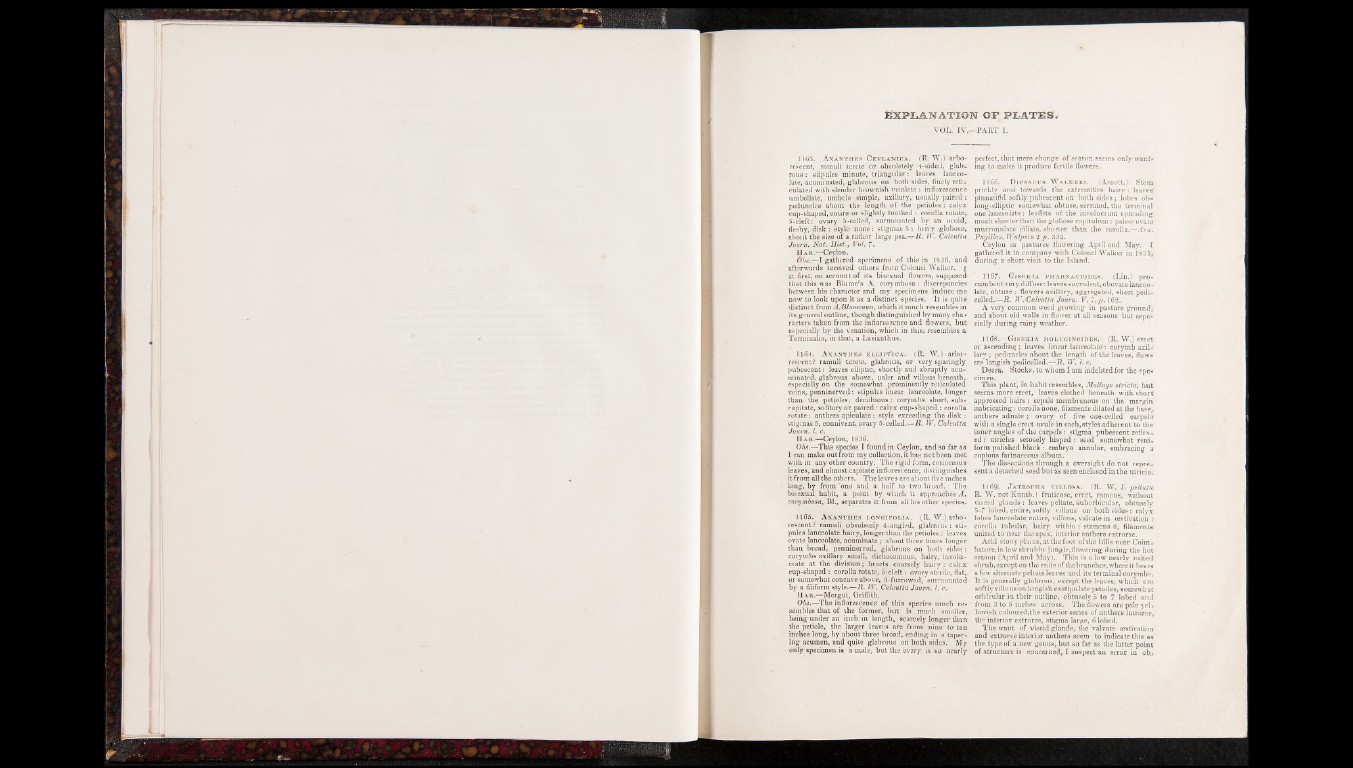
Ex p la n a t io n of p l a t e s ,
VOL. IV.—PART I.
1163. Axantiies C ey lan ica . (R. W.) arborescent,
ramuli terete or obsoletely 4-sided, glabrous
: stipules minute, triangular: leaves lanceolate,
acuminated, glabrous on both sides, finely reticulated
with slender brownish veinlets :■ inflorescence
umbellate, umbels simple,- axillary, usually paired:
peduncles about the length of the petioles: calyx
cup-shaped, entire or slightly toothed :• corolla rotate/
5-cleft: ovary 5-celled, surmounted by an ovoid,
fleshy, disk: style none: stigmas 5 : berry globose,
ahout the size of a rather large pea.—R. W. Calcutta
Journ. Nat. Hist., Vol. 7.
Ha b .—Ceylon.
Obs.—I gathered specimens of this in 1836, and
afterwards received others from Colonel Walker, f
at first, on account of its bisexual flowers, supposed
that this was Blume’s A. corymbosa: discrepancies
between his character and my specimens induce me
now to look upon it as a distinct species. It is quite
distinct from A.Bluntcana, which it much resembles in
its general outline, though distinguished by many characters
taken from the inflorescence and flowers, but
especially by the venation, which in this, resembles a
Terminalia, in that, a Lasianthus.
1164. A xantites' e l Lipt'ica . (R. W .^arb orescent?
ramuli terete, glabrous, or very sparingly
pubescent: leaves elliptic, shortly and abruptly acuminated,
glabrous above, paler and villous beneath,
especially on the somewhat prominently reticulated
veins', penninerved stipules linear lanceolate, longer
than the petioles, deciduous: corymbs short, sub-
capitate, solitary or paired : calyx cup-shaped : corolla
rotate: anthers apiculate: style exceeding the disk :
stigmas 5, connivent, ovary 5-celled.—R. TV. Calcutta
Journ. 1. c'.
Ha b .—Ceylon, 1836-.
Obs.—This species I found in Ceylon, and so far as
1 can make out from my collection, it has not been met
with in any other country. The rigid form, coriaceous
leaves, and almost capitate inflorescence, distinguishes
it from all the others. The leaves are about five inches
long, by from ’one and a half to two broad. The
bisexual habit, a point by which it approaches A.
corymbosa, Bl., separates it from all his other species.
1165. Axanthes longifo l ia . (R. W.) arborescent
? ramuli obsoletely 4-angled, glabrous : stipules
lanceolate hairy, longer than the petioles : leaves
ovate lanceolate, acuminate; about three times longer
than broad, penninerved, glabrous on both sides r-
corymbs axillary small, dichotomous, hairy, involu-
crate at the division j bracts coarsely hairy : calyx
cup-shaped : corolla rotate, 5’-cleft: ovary sterile, flat,
or somewhat concave above, 5-furrowed, surmounted
by a filiform style.—R. TV. Calcutta Journ. 1. c.
Ha b .—Mergui, Griffith.
Obs.—The inflorescence of this species much resembles
that of the former, but is much smaller,
being under an inch in length, scarcely longer than
the petiole, the larger leaves are from nine to ten
inches long, by about three broad, ending in a tapering
acumen, and quite glabrous on both sides. My
only specimen is a male, but the ovary is so nearly
perfect, that mere change of season seems only want-'
ing to make it produce fertile flowers.
' lfl66> Dipsacus Wa lkeri. lArnolt.) Stem
prickly and towards the extremities hairy: leaves-
pinnatifid softly pubescent on both sides; lobes ob-
iong-elliptic somewhat obtuse, serrated, the terminal
one lanceolate : leaflets of the involucrum spreading
much shorter than the globose capitulum : paleoe ovate-
mucronulate ciliate, shorter than the corolla.—Am.
Pugillus. Walpers 2 p. 332.
Ceylon in pastures flowering April and May. I
gathered it in company with Colonel Walker in 1835,-
during a short visit to the Island.
1167’-. Gisekia pharnaciodes. (Lin.) procumbent
very diffuse: leaves succulent,obovate lanceolate,
obtuse : flowers axillary, aggregated, short pedi-
celled.— R. W^Calcutta Journ. V. 7 ,p . 162.
A very common weed growing in pasture ground/
and about old walls in flower at all seasons but especially
during rainy weather.
1168. Gisekia moluginoides. (R. W.) erect
or ascending; leaves linear lanceolate: corymb axillary
; peduncles about the length of the leaves, flowers
longish pedicelled.—R. TV. 1. c.
Deesa. Stocks, to whom I am indebted for the specimen.
This plant, m habit resembles, Mollugo stricta, but
seems more erect, leaves clothed beneath with short
appressed hairs ; sepals membranous on the margin
imbricating:' corolla none, filaments dilated at the base,
anthers adnate; ovary of five orre-celled carpels1
with a single erect ovule in each,styles adherent to the
inner angles of the carpels : stigma pubescent reflexed
:; utricles setosely hisped : seed somewhat reni-
form polished black : embryo annular, embracing a
copious farinaceous album.
The dissections through a oversight do not represent
a detached seed but as seen enclosed in the utricle.
1169. J atropha villosa. (R. W. I. peltata
R. W. not Kuntb.) fruticose, erect, ramous, without
visced glands : leave's peltate, suborbicular, obtusely
5-7 lobed, entire, softly villous on both sides :• calyx
lobes lanceolate entire, villous, valvate in oestivation ::
corolla tubular, hairy within: stamens 8, filaments
united to near the apex, interior anthers extrorse.
Arid stony plains, at the foot of the hills near Coimbatore,
in low shrubby jungle,flowering during the hot
season (April and May). This is a low nearly naked
shrub, except on the ends of thebranches, where it bears
a few alternate peltate leaves and its terminal corymbs.
It is generally glabrous, except the leaves, which are
softly villous on longish exstipulate petioles, somewhat
orbicular in their outline, obtusely 5 to 7 lobed and
from 3 to 5 inches across. The flowers are pale yellowish
coloured,the exterior series of anthers introrse,
the interior extrorse, stigma large, 6 lobed.
The want of viscid glands, the valvate oestivation
and extrorse interior anthers seem to indicate this as
the type of a new genus, ,but so far as the latter point
of structure is concerned, I suspect an error in obj